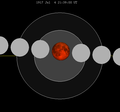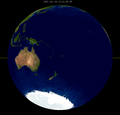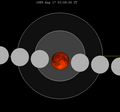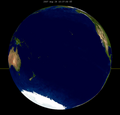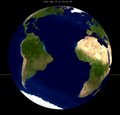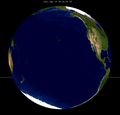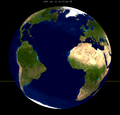Summary
This eclipse is a part of Saros series 128, repeating every 18 years, 11 days, and containing 71 events. The series started with a penumbral lunar eclipse on June 18, 1304. It contains partial eclipses from September 2, 1430 through May 11, 1827; total eclipses from May 21, 1845 through October 21, 2097; and a second set of partial eclipses from November 2, 2115 through May 17, 2440. The series ends at member 71 as a penumbral eclipse on August 2, 2566.
The longest duration of totality was produced by member 37 at 100 minutes, 43 seconds on July 26, 1953. All eclipses in this series occur at the Moon’s ascending node of orbit. [2]
| Greatest | First |
|---|

The greatest eclipse of the series occurred on 1953 Jul 26 , lasting 100 minutes, 43 seconds. [3] | Penumbral | Partial | Total | Central |
|---|
1304 Jun 18
| 1430 Sep 02
| 1845 May 21
| 1899 Jun 23
|
| Last |
|---|
| Central | Total | Partial | Penumbral |
|---|
2007 Aug 28
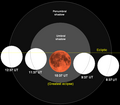 | 2097 Oct 21
 | 2440 May 17
| 2566 Aug 02
|
Eclipses are tabulated in three columns; every third eclipse in the same column is one exeligmos apart, so they all cast shadows over approximately the same parts of the Earth.
Lunar Saros 128 contains 15 total lunar eclipses between 1845 and 2097 (in years 1845, 1863, 1881, 1899, 1917, 1935, 1953, 1971, 1989, 2007, 2025, 2043, 2061, 2079 and 2097). Solar Saros 135 interleaves with this lunar saros with an event occurring every 9 years 5 days alternating between each saros series.
This page is based on this
Wikipedia article Text is available under the
CC BY-SA 4.0 license; additional terms may apply.
Images, videos and audio are available under their respective licenses.





